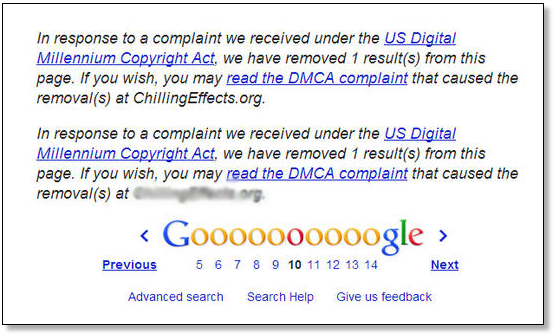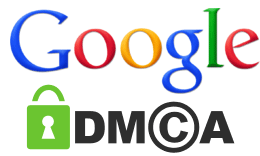

2017-02-09 | 12165 ![]() Print
Print ![]() PDF
PDF
Have you been so unfortunate to search a keyword your website was ranking for on Google and then noticed that your webpage is no longer ranking for that particular keyword?, instead you can only see on the search engine ranking page that there has been a notice stating the reason why your keyword is not probably ranking any more.

Such cases can affect sites that build their traffic around blog post, as they are prone to plagiarism and hence get penalized by Google if such cases are submitted to them.
Most people consider plagiarism as an act of copying someone else's work or borrowing an original ideas and using it as one's own original content without referencing or pointing back to the original author or content. But terms like "copying" and "borrowing" can disguise the seriousness of the offense:
In other words, plagiarism is an act of fraud. It involves both stealing someone else's work and lying about it afterward.
According to U.S. law, the answer is yes. The expression of original ideas is considered intellectual property and is protected by copyright laws, just like original inventions. Almost all forms of expression fall under copyright protection as long as they are recorded in some way (such as a book or a computer file).
Most cases of plagiarism can be avoided, however, by citing sources. Simply acknowledging that certain material has been borrowed and providing your audience with the information necessary to find that source is usually enough to prevent plagiarism.
Using an image, video or piece of music in a work you have produced without receiving proper permission or providing appropriate citation is plagiarism. The following activities are very common in today’s society. Despite their popularity, they still count as plagiarism.
Copying media (especially images) from other websites to paste them into your own papers or websites.
Making a video using footage from others’ videos or using copyrighted music as part of the soundtrack.
Performing another person’s copyrighted music (i.e., playing a cover).
Composing a piece of music that borrows heavily from another composition.
Certainly, these media pose situations in which it can be challenging to determine whether or not the copyrights of a work are being violated. For example:
A photograph or scan of a copyrighted image (for example: using a photograph of a book cover to represent that book on one’s website)
Recording audio or video in which copyrighted music or video is playing in the background.
Re-creating a visual work in the same medium. (for example: shooting a photograph that uses the same composition and subject matter as someone else’s photograph)
Re-creating a visual work in a different medium (for example: making a painting that closely resembles another person’s photograph).
Re-mixing or altering copyrighted images, video or audio, even if done so in an original way.
The legality of these situations, and others, would be dependent upon the intent and context within which they are produced. The two safest approaches to take in regards to these situations is: 1) Avoid them altogether or 2) Confirm the works’ usage permissions and cite them properly.
Such is the case with the introduction of the DMCA take down that enables you to file a complaint to remove contents from Google that are deemed infringed and against the copyright law of US.

With the DMCA takedown notice an original content owner can now write against another site (can be a competitor) if it notice that they are using any part of their original content materials. The verge.com stated Google received just over 75 million DMCA-related takedown requests in the month of March 2016, representing a new high as content owners seek to keep pirate websites out of search results and invisible to people searching for leaked album downloads, movies, and other media. The rate at which the requests have grown is truly staggering; TorrentFreak says Google is effectively processing over 100,000 URLs per hour. Compare that to 2014, when Google handled 345 million requests for the entire year.
Types of Plagiarism
Anyone who has written or graded a paper knows that plagiarism is not always a black-and-white issue. The boundary between plagiarism and research is often unclear. Learning to recognize the various forms of plagiarism, especially the more ambiguous ones, is an important step in the fight to prevent it.
I. SOURCES NOT CITED
1) “The Ghost Writer” The writer turns in another’s work, word-for-word, as his or her own.
2) “The Photocopy” The writer copies significant portions of text straight from a single source, without alteration.
3) “The Potluck Paper” The writer tries to disguise plagiarism by copying from several different sources, tweaking the sentences to make them fit together while retaining most of the original phrasing.
4) “The Poor Disguise” Although the writer has retained the essential content of the source, he or she has altered the paper’s appearance slightly by changing key words and phrases.
5) “The Labor of Laziness” The writer takes the time to paraphrase most of the paper from other sources and make it all fit together, instead of spending the same effort on original work.
6) “The Self-Stealer” The writer “borrows” generously from his or her previous work, violating policies concerning the expectation of originality adopted by most academic institutions.
II. SOURCES CITED (but still plagiarized!)
1) “The Forgotten Footnote” The writer mentions an author’s name for a source, but neglects to include specific information on the location of the material referenced. This often masks other forms of plagiarism by obscuring source locations.
2) “The Misinformer” The writer provides inaccurate information regarding the sources, making it impossible to find them.
3) “The Too-Perfect Paraphrase” The writer properly cites a source, but neglects to put in quotation marks text that has been copied word-for-word, or close to it. Although attributing the basic ideas to the source, the writer is falsely claiming original presentation and interpretation of the information.
4) “The Resourceful Citer” The writer properly cites all sources, paraphrasing and using quotations appropriately. The catch? The paper contains almost no original work! It is sometimes difficult to spot this form of plagiarism because it looks like any other well-researched document.
5) “The Perfect Crime” Well, we all know it doesn’t exist. In this case, the writer properly quotes and cites sources in some places, but goes on to paraphrase other arguments from those sources without citation. This way, the writer tries to pass off the paraphrased material as his or her own analysis of the cited material.
In addition to the video explanation here are some methods one can use to avoid such cases of plagiarism. If you have other lovely methods that can help avoid plagiarism please do add to the current list with your comments below.
4 Ways To Help Avoid Plagiarism
1.) Always utilize quotations and cite to highlight content that are pulled out from an original content to validate or backup your own write up in the same context.
2.) Provide a link back or reference to the original content, mentioning the author and other means of identifying/finding the author.
3.) Avoid copying word for word and master how to effectively use paraphrase as overdoing it can also land you into the issue of plagiarism.
4.) Always validate the authenticity of the content you are about to use against its originality, so as not to utilize an already plagiarized work or fall short to accidental plagiarism.
Follow all this concise methods to improve your post content and avoid being hit by Google DMCA Take down notice...if you find yourself with such notice simply visit lumendatabase.org and do a search for the keyword to know the website that filed the complaint and edit the page that is effected on your website for re-indexing by Google.
This process might take a while to turn around, but in due time you will be able to rank for your lose keywords. Do note that the keyword may fall behind it's original position but with time it will regain it's original content.
Sources used for this post:
What is Plagiarism http://www.plagiarism.org/plagiarism-101/what-is-plagiarism
Types of plagiarism by Turnitin.com and Research Resources
Editage - Tips to avoid Accidental Plagiarism

I am a seo web analyst and have a love for anything online marketing. Have been able to perform researches using the built up internet marketing tool; seo web analyst as a case study and will be using the web marketing tool (platform).
How To Reactivate Google Adsense Account
How Do You Write Pitch Deck That Wins Investors
Effective Lead Magnet Funnel Examples For Businesses
How To Promote FMCG Products Using Digital Marketing
The Main Objectives Of SEO in Digital Marketing
How Artificial Intelligence Is Transforming Digital Marketing
Google CEO Sundar Pichai: Search will profoundly change in 2025
3 Most Important Business Growth Strategies
Top 20 Work From Home Job Skills
SEO Tips and Strategies For Small Businesses